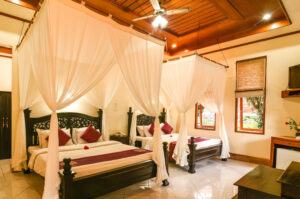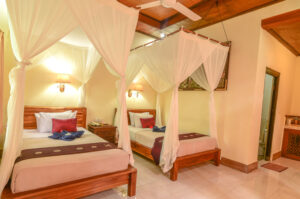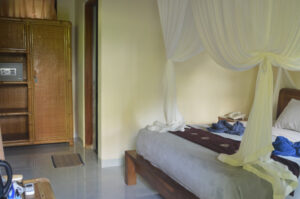
Suite Family
This room is the best we have its two type of bed double or triple bed, has rice field view and garden, furnished by teakwood.
Home » The History Of Ubud
Ubud has a recognized history in the 8th century. Ubud comes from the word “Ubad” which means medicine. When the Javanese Hindu priest Rsi Markandya watches Bali from Java, and meditates at the confluence of the two Wos rivers in Campuhan, just west of the contemporary city centre. A temple was founded and later expanded by Nirartha, a Javanese priest who is associated as the founder of Balinese religious traditions and routines as we understand them today. Currently the area is a center for alternative medicine and healing
Additional temples and monasteries were developed over the next 400 years or so. The temple complex at Gunung Kawi and the cave temple at Goa Gajah are architectural relics from this period. Most of the dances, plays and routines that are still practiced in Ubud today, date back to this time. Raja Airlangga ruled all of Java and Bali during this period, and the center of his federal government was located in what is now the village of Batuan, just southeast of Ubud.
The Javanese Majapahit Empire conquered Bali in 1343, and the key to the final victory was against the Pejeng Dynasty centered in Bedulu, just east of Ubud. Balinese culture thrived, and the ancestors of today’s Ubud aristocratic families can be traced back to this period. In the 16th century, there was a total displacement of the Majapahit Kingdom to Bali because the Islamization of Java forced them to the east.
In 1900, Ubud became a Dutch protectorate at its own request, and the colonialists intervened little, so the traditional arts and culture of the area remained relatively unchanged. The modern era of Ubud probably began in the 1930s, when foreign artists were encouraged by the royal family to be present in the city. From the 1960s onwards, tourists began to arrive in earnest, mostly the brave type because the infrastructure was still very limited. Since then, Ubud has grown rapidly into a renowned upscale international destination, while maintaining its integrity as the center of Balinese arts and culture.

This room is the best we have its two type of bed double or triple bed, has rice field view and garden, furnished by teakwood.

Same like standard room, we also have room with Fan and air Conditioning. Our room with Fan is a Triple bed room (double + single

We have 2 different of standard, with fan and Air Conditioning. Our room with fan we have twin/double bed and also have room for family
WhatsApp us